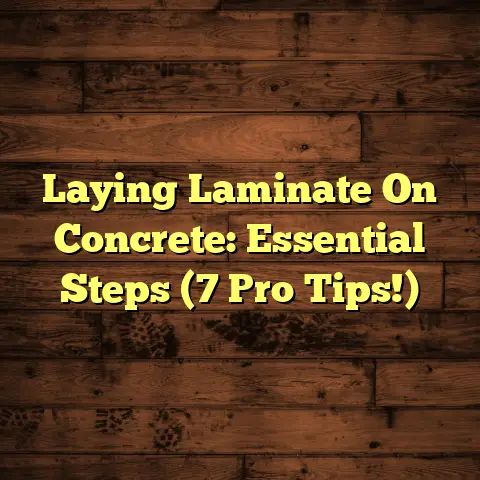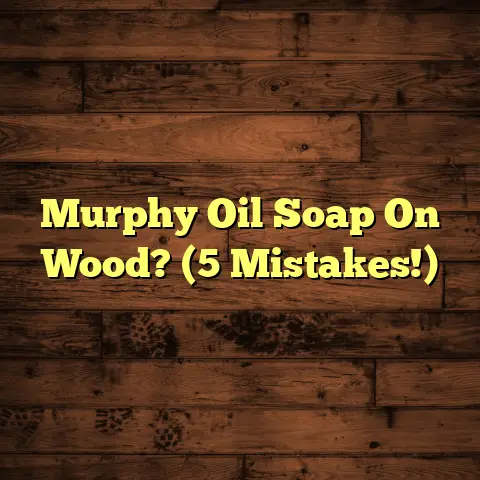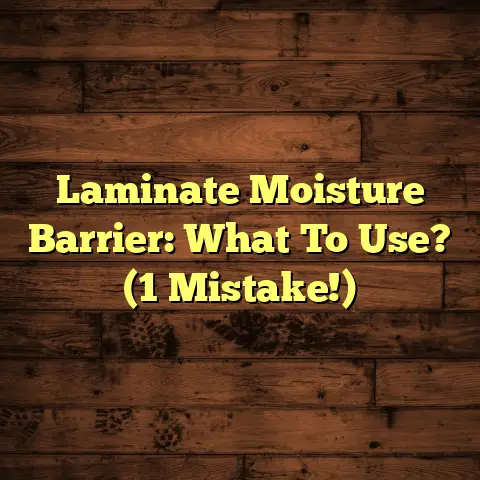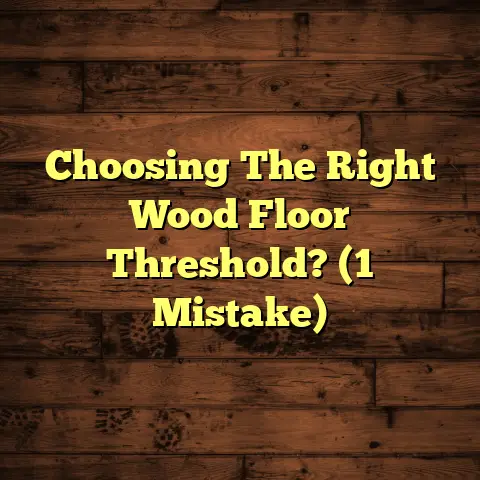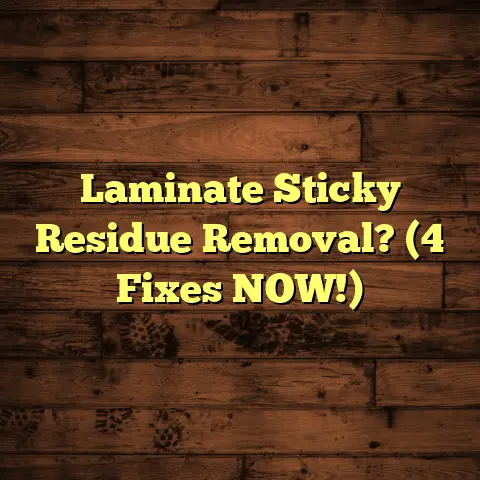Non-Toxic Floor Cleaners? (3 Mistakes Costing You!)
I’ve seen it all, from gleaming hardwood to grimy tile.
But lately, I’ve noticed a growing concern among my clients: how to keep their floors sparkling clean without exposing their families to harsh chemicals.
Are you unknowingly exposing your loved ones to harmful toxins while trying to create a clean and safe home?
It’s a challenge I understand, and that’s why I’m here to shed light on the common mistakes people make when choosing non-toxic floor cleaners – and how to avoid them.
The Importance of Non-Toxic Cleaning Solutions
Let’s face it, we’re all becoming more aware of what we’re putting into our homes.
There’s a growing demand for cleaning products that are safe for our families, our pets, and the environment.
Conventional floor cleaners can be loaded with harsh chemicals that pose significant health risks.
Think about it: respiratory issues, skin irritations, and even potential long-term health problems.
I’ve personally seen clients develop allergic reactions they believe are directly tied to the chemicals they use to clean their floors.
And it’s not just about our health.
These toxic cleaning agents can also wreak havoc on the environment, polluting our water sources and harming wildlife.
According to the EPA, many common cleaning products release volatile organic compounds (VOCs), contributing to indoor air pollution and smog.
But here’s the good news: non-toxic alternatives are becoming more effective and readily available.
A study published in the Environmental Science & Technology journal showed that plant-based cleaners can be just as effective as conventional cleaners in removing dirt and grime, without the harmful side effects.
So, why not make the switch?
Mistake #1 – Overlooking Ingredient Labels
This is where things get real.
You have to read those labels!
Understanding what constitutes a non-toxic cleaner is crucial.
I can’t tell you how many times I’ve seen people grab a bottle off the shelf without even glancing at the ingredients.
Big mistake.
Conventional floor cleaners often contain a cocktail of harmful ingredients, including:
- Phthalates: Endocrine disruptors linked to reproductive issues and developmental problems.
- Formaldehyde: A known carcinogen that can cause respiratory irritation and allergic reactions.
- Ammonia: A powerful irritant that can damage the respiratory system and cause burns.
- Triclosan: An antibacterial agent that can disrupt hormones and contribute to antibiotic resistance.
- Perchloroethylene (PERC): A neurotoxin and possible carcinogen.
These are just a few of the nasties lurking in your cleaning supplies.
So, what should you look for in non-toxic products?
- Certifications: Look for labels like “EPA Safer Choice,” “Green Seal,” or “EcoLogo.” These certifications indicate that the product has been independently tested and meets strict environmental and health standards.
- Plant-Based Ingredients: Opt for products that use plant-derived ingredients like coconut oil, essential oils, and vinegar.
- Transparency: Choose brands that are upfront about their ingredients and manufacturing processes.
- Avoid “Fragrance”: This is a catch-all term that can hide a multitude of harmful chemicals. Look for products that use essential oils for scent or are fragrance-free.
I remember one client who was convinced she was using a safe cleaner because it smelled “natural.”
Turns out, it was loaded with synthetic fragrances and preservatives!
Don’t fall for misleading marketing tactics. Read the label, do your research, and make informed choices.
Mistake #2 – Believing All ‘Natural’ Products Are Safe
Okay, this is a tricky one.
Just because a product is labeled “natural” or “eco-friendly” doesn’t automatically mean it’s safe.
Unfortunately, there’s a lot of greenwashing going on in the cleaning industry.
Greenwashing is when a company deceptively promotes their products as environmentally friendly, even if they contain harmful ingredients.
The problem is, there’s a lack of strict regulation in labeling.
Brands can exploit this to mislead consumers into thinking they’re buying something safe when they’re not.
I’ve seen products marketed as “natural” that still contain hidden chemicals like:
- Sodium Lauryl Sulfate (SLS): A surfactant that can irritate skin and eyes.
- Propylene Glycol: A solvent that can cause allergic reactions and respiratory problems.
- Methylisothiazolinone (MIT): A preservative that can trigger allergic contact dermatitis.
These ingredients may be derived from natural sources, but they can still be harmful.
So, how can you verify the safety of products before purchasing them?
- Check the Full Ingredient List: Don’t just rely on the front label. Read the entire ingredient list carefully.
- Research Ingredients: Use online resources like the Environmental Working Group’s (EWG) Skin Deep database to research the safety of individual ingredients.
- Look for Third-Party Certifications: As mentioned earlier, certifications like “EPA Safer Choice” and “Green Seal” provide an extra layer of assurance.
- Read Reviews: See what other consumers are saying about the product. Look for reviews that mention potential health concerns or allergic reactions.
One of my colleagues, who is also a mom, shared a story about a “natural” baby floor cleaner that gave her child a rash.
After doing some digging, she discovered that it contained a preservative that’s known to be a skin irritant.
The lesson here is clear: don’t blindly trust marketing claims. Do your homework and be a savvy consumer.
Mistake #3 – Neglecting DIY Alternatives
Alright, let’s talk about my favorite solution: DIY!
Creating your own non-toxic floor cleaners is not only safe and cost-effective, but it’s also incredibly empowering.
You know exactly what’s going into your cleaner, and you can customize it to suit your specific needs.
Plus, it’s a great way to reduce plastic waste.
I’ve been making my own floor cleaners for years, and I’ve never looked back.
Here are a few simple, effective recipes to get you started:
1. All-Purpose Floor Cleaner (for tile, laminate, and vinyl):
- 1/2 cup white vinegar
- 1 gallon warm water
- 10-15 drops of your favorite essential oil (lemon, lavender, or tea tree work well)
Instructions: Combine all ingredients in a bucket. Mop floor as usual.
2. Hardwood Floor Cleaner:
- 1/4 cup white vinegar
- 1 gallon warm water
- A few drops of mild dish soap (optional)
Instructions: Combine all ingredients in a bucket. Mop floor with a damp mop, being careful not to over-wet the wood.
3. Baking Soda Scrub (for tough stains):
- Baking soda
- Water
Instructions: Make a paste of baking soda and water. Apply to the stain and let it sit for a few minutes. Scrub gently with a soft cloth or sponge. Rinse with water.
These recipes are incredibly simple, but they’re surprisingly effective.
I’ve had clients tell me that their homemade cleaners work better than anything they’ve ever bought in a store!
One client, who was struggling with allergies, completely switched to DIY cleaners and saw a significant improvement in her symptoms.
She said it was like a breath of fresh air for her home.
And let’s not forget the environmental benefits.
By making your own cleaners, you’re reducing your reliance on plastic bottles and contributing to a more sustainable lifestyle.
It’s a win-win for your health, your wallet, and the planet.
The Path Forward
Okay, let’s recap.
We’ve covered the three biggest mistakes people make when choosing non-toxic floor cleaners:
- Overlooking ingredient labels
- Believing all “natural” products are safe
- Neglecting DIY alternatives
I hope this article has empowered you to make more informed choices when it comes to cleaning your floors.
It’s time to reevaluate your cleaning products and consider safer alternatives.
Your health, your family, and the environment will thank you for it.
Remember, creating a healthier living environment is a journey, not a destination.
Start small, make gradual changes, and don’t be afraid to experiment.
You’ve got this!
Conclusion: Wrap Up Your Message
We started with a challenge: finding safe, effective cleaning solutions for our homes.
I’ve armed you with the knowledge to navigate the world of non-toxic floor cleaners and avoid common pitfalls.
Now, it’s your turn to take action.
Share your experiences, your tips, and your favorite DIY recipes in the comments below.
Let’s create a community of informed homeowners who are committed to creating healthier, more sustainable homes.
By choosing non-toxic options, you’re not just protecting your individual health – you’re contributing to the well-being of the planet.
And that’s something we can all be proud of.
So, go forth and clean with confidence!
